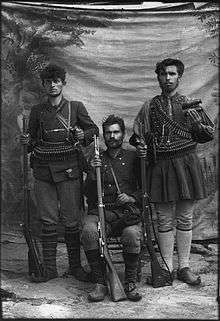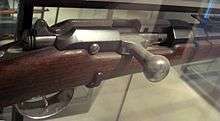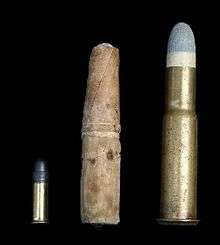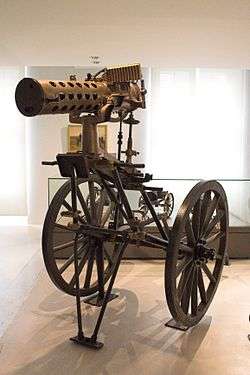Fusil Gras mle 1874
The Fusil Modèle 1874 or Gras was the French Army's primary service rifle from 1874 to 1886. Designed by Colonel Basile Gras, the Gras was a metallic cartridge adaptation of the single-shot, breech-loading, black powder Chassepot rifle. It was developed from 1872 to 1874 as a response to the German adoption of the Mauser Model 1871 metallic cartridge rifle.
| Fusil Modèle 1874 or Fusil Gras | |
|---|---|
 Fusil Gras M80 1874 | |
| Type | Bolt-action rifle |
| Place of origin | France |
| Service history | |
| In service | 1874–1940 |
| Used by | France Other users |
| Wars | See conflicts |
| Production history | |
| Designed | 1872–1874 |
| Manufacturer | Manufacture d'armes de Saint-Étienne and Steyr |
| No. built | 2,500,000 |
| Variants | M80 M14 |
| Specifications | |
| Mass | 4.2 kg (9.3 lb) 3.6 kg (7.9 lb) (cavalry) 3.2 kg (7.1 lb) (Artillery) |
| Length | 1,310 mm (52 in) 1,175 mm (46.3 in) (cavalry) 995 mm (39.2 in) (Artillery) |
| Barrel length | 795 mm (31.3 in) 680 mm (27 in) (cavalry) 490 mm (19 in) (Artillery) |
| Cartridge | 11×59mmR Gras[1] 8×50mmR Lebel |
| Action | Bolt action |
| Muzzle velocity | 454 m/s (1,490 ft/s) 350 m/s (1,100 ft/s) (Carvalry) |
| Feed system | Single shot M80: 10 round gravity hopper |
| Sights | Iron sights |
Modified in 1880 as the M80 with an improved breechblock and in 1914 as the M14 to accommodate the 8×50mmR Lebel smokeless powder cartridge, the Gras was replaced as the standard-issue service rifle by the Lebel in 1886.
Description

Converted from the Chassepot, the Gras[2] was in 11 mm (0.43 in) caliber and used black powder centerfire metallic cartridges with a 385 gr (24.9 g; 0.88 oz) bullet over a 78 gr (5.1 g; 0.18 oz) charge. It was a robust and hard-hitting single-shot weapon. Additionally it had a triangular-shaped Model 1874 "Gras" sword bayonet. The Gras rifle was replaced from 1886 by the Lebel rifle.
Development
The Gras was manufactured in response to the development of the Boxer cartridge in 1866, and the British 1870 Martini–Henry rifle which used it.[3] Those were soon emulated by the Germans with the 1871 Mauser.[3] The French Army set up a study group in September 1872 that chose the metallic over the paper cartridge. A second study group in 1873 looked at various metallic cartridge adaptations. Colonel Gras proposed a modification of the Chassepot to accept metal cartridges and on 7 July 1874, the French Army chose his design over the Dutch Beaumont M1871 rifle.
History

The Hellenic Army adopted the Gras in 1877, and it was used in all conflicts until the Second World War. It became the favourite weapon of Greek guerrilla fighters,[4] from the various revolts against the Ottoman Empire to the resistance against the Axis, acquiring legendary status. The name entered the Greek language, and grades (γκράδες) was a term colloquially applied to all rifles during the first half of the 20th century. It was manufactured by Manufacture d'armes de Saint-Étienne, one of several government-owned arms factories in France. However most of the Gras rifles (60,000) used by the Hellenic military were manufactured under licence by Steyr in Austria.
The Gras rifle was partly the inspiration for the development of the Japanese Murata rifle, Japan's first locally-made service rifle.
According to the Vietnamese historian Phạm Văn Sơn, a Vietnamese general in the Cần Vương movement, Cao Văn Thắng, managed to copy the design of "an 1874 type fast-firing rifle of French". However, the Vietnamese version did not have a rifled barrel, and the range was limited.[5]
In 1915, 450,000 Gras rifles were sent to the Russian Empire.
After 1918, Mle 1874 rifles were exported to Yugoslavia, Poland and Greece.[6]
Modifications during World War I
Modified rifle
In 1914, the French Army modified 146,000 rifles to fire 8 mm Lebel in 1914, by using the barrel of a Lebel or Berthier rifle. They were used by second-line troops. In 1940, after the French defeat, most of these rifles were destroyed by the German occupiers.[7]
Grenade Launcher
Gras rifles and the 11x59mmR cartridges were also widely used by front line troops as converted grenade launchers, known as Bombardes DR (grenade throwers) these conversions had cut down barrels and butts of varying workmanship and fired blank cartridges to propel the grenade, and were used as a crude form of trench mortar.
Users
.svg.png)



.svg.png)
.gif)
.svg.png)

.svg.png)

.svg.png)



.svg.png)
.svg.png)

.svg.png)
Conflicts
- French colonial expeditions
- Sino-French War
- War of the Pacific
- Chilean Civil War of 1891
- First Italo-Ethiopian War
- Thousand Days' War
- Greco-Turkish War (1897)
- Balkan Wars
- World War I[7]
- Irish revolutionary period
- Greco-Turkish War (1919–22)
- Second Italo-Ethiopian War
- Spanish Civil War
- World War II[7]
Comparison with contemporary rifles
| Calibre | System | Country | Velocity | Height of trajectory | Ammunition | ||||||||
|---|---|---|---|---|---|---|---|---|---|---|---|---|---|
| Muzzle | 500 yd (460 m) | 1,000 yd (910 m) | 1,500 yd (1,400 m) | 2,000 yd (1,800 m) | 500 yd (460 m) | 1,000 yd (910 m) | 1,500 yd (1,400 m) | 2,000 yd (1,800 m) | Propellant | Bullet | |||
| .433 in (11.0 mm) | Werndl–Holub rifle | Austria-Hungary | 1,439 ft/s (439 m/s) | 854 ft/s (260 m/s) | 620 ft/s (190 m/s) | 449 ft/s (137 m/s) | 328 ft/s (100 m/s) | 8.252 ft (2.515 m) | 49.41 ft (15.06 m) | 162.6 ft (49.6 m) | 426.0 ft (129.8 m) | 77 gr (5.0 g) | 370 gr (24 g) |
| .45 in (11.43 mm) | Martini–Henry | United Kingdom | 1,315 ft/s (401 m/s) | 869 ft/s (265 m/s) | 664 ft/s (202 m/s) | 508 ft/s (155 m/s) | 389 ft/s (119 m/s) | 9.594 ft (2.924 m) | 47.90 ft (14.60 m) | 147.1 ft (44.8 m) | 357.85 ft (109.07 m) | 85 gr (5.5 g) | 480 gr (31 g) |
| .433 in (11.0 mm) | Fusil Gras mle 1874 | France | 1,489 ft/s (454 m/s) | 878 ft/s (268 m/s) | 643 ft/s (196 m/s) | 471 ft/s (144 m/s) | 348 ft/s (106 m/s) | 7.769 ft (2.368 m) | 46.6 ft (14.2 m) | 151.8 ft (46.3 m) | 389.9 ft (118.8 m) | 80 gr (5.2 g) | 386 gr (25.0 g) |
| .433 in (11.0 mm) | Mauser Model 1871 | Germany | 1,430 ft/s (440 m/s) | 859 ft/s (262 m/s) | 629 ft/s (192 m/s) | 459 ft/s (140 m/s) | 388 ft/s (118 m/s) | 8.249 ft (2.514 m) | 48.68 ft (14.84 m) | 159.2 ft (48.5 m) | 411.1 ft (125.3 m) | 75 gr (4.9 g) | 380 gr (25 g) |
| .408 in (10.4 mm) | M1870 Italian Vetterli | Italy | 1,430 ft/s (440 m/s) | 835 ft/s (255 m/s) | 595 ft/s (181 m/s) | 422 ft/s (129 m/s) | 304 ft/s (93 m/s) | 8.527 ft (2.599 m) | 52.17 ft (15.90 m) | 176.3 ft (53.7 m) | 469.9 ft (143.2 m) | 62 gr (4.0 g) | 310 gr (20 g) |
| .397 in (10.08 mm) | Jarmann M1884 | Norway and Sweden | 1,536 ft/s (468 m/s) | 908 ft/s (277 m/s) | 675 ft/s (206 m/s) | 504 ft/s (154 m/s) | 377 ft/s (115 m/s) | 7.235 ft (2.205 m) | 42.97 ft (13.10 m) | 137.6 ft (41.9 m) | 348.5 ft (106.2 m) | 77 gr (5.0 g) | 337 gr (21.8 g) |
| .42 in (10.67 mm) | Berdan rifle | Russia | 1,444 ft/s (440 m/s) | 873 ft/s (266 m/s) | 645 ft/s (197 m/s) | 476 ft/s (145 m/s) | 353 ft/s (108 m/s) | 7.995 ft (2.437 m) | 47.01 ft (14.33 m) | 151.7 ft (46.2 m) | 388.7 ft (118.5 m) | 77 gr (5.0 g) | 370 gr (24 g) |
| .45 in (11.43 mm) | Springfield model 1884 | United States | 1,301 ft/s (397 m/s) | 875 ft/s (267 m/s) | 676 ft/s (206 m/s) | 523 ft/s (159 m/s) | 404 ft/s (123 m/s) | 8.574 ft (2.613 m) | 46.88 ft (14.29 m) | 142.3 ft (43.4 m) | 343.0 ft (104.5 m) | 70 gr (4.5 g) | 500 gr (32 g) |
| .40 in (10.16 mm) | Enfield-Martini | United Kingdom | 1,570 ft/s (480 m/s) | 947 ft/s (289 m/s) | 719 ft/s (219 m/s) | 553 ft/s (169 m/s) | 424 ft/s (129 m/s) | 6.704 ft (2.043 m) | 39.00 ft (11.89 m) | 122.0 ft (37.2 m) | 298.47 ft (90.97 m) | 85 gr (5.5 g) | 384 gr (24.9 g) |
Gallery
 Fusil Gras M80 1874 breech portion
Fusil Gras M80 1874 breech portion Fusil Gras M80 Mle 1874 metallic cartridge
Fusil Gras M80 Mle 1874 metallic cartridge Fusil Gras modified in 1883 with 10-cartridge gravity hopper
Fusil Gras modified in 1883 with 10-cartridge gravity hopper R: 11×59.5 mm R metallic cartridge for Fusil Gras mle 1874
R: 11×59.5 mm R metallic cartridge for Fusil Gras mle 1874 1875 Gras bayonet
1875 Gras bayonet.jpg) Bombardes DR
Bombardes DR
Notes
- "Archived copy". Archived from the original on 2008-06-01. Retrieved 2009-12-15.CS1 maint: archived copy as title (link)
- "11x59R French Gras" in Barnes, Frank C. Cartridges of the World (DBI, 1972), P.199.
- The Tools of Empire by Daniel R. Headrick p.98
- Jowett, Philip (20 Jul 2015). Armies of the Greek-Turkish War 1919–22. Men-at-Arms 501. Osprey Publishing. p. 22. ISBN 9781472806840.
- Phạm Văn Sơn, Việt sử tân biên (quyển 5, tập trung). Tác giả tự xuất bản, Sài Gòn. 1963. p. 147
- Gander, Terry (2000). Allied Infantry Weapons of World War Two. The Crowood Press. pp. 31-32. ISBN 9781861263544.
- Guillou, Luc (April 2014). "Un centenaire bien oublié : le fusil Gras modifié 14 : "le fusil des pépères"". La Gazette des Armes (in French). No. 463. pp. 32–36.
- Terlinden, Ch. (January 1932). "Les Campagnes Belges dans l'Est Africain Allemand (1914-1917)". Revue d'histoire des colonies (in French). 20 (85): 77–98. doi:10.3406/outre.1932.1088.
- Brousmiche, Jean-Marie (June 2016). "La Force Publique congolaise (2)" (PDF). Mémoires du Congo (in French). No. 38. pp. 4–7.
- Ball, Robert W. D. (2011). Mauser Military Rifles of the World. Iola: Gun Digest Books. p. 81. ISBN 9781440228926.
- Henderson, James D. (1985). When Colombia Bled: A History of the Violencia in Tolima. University, Ala.: The University of Alabama Press. pp. 71, 175, 295. ISBN 9780817302122.
- Jowett, Philip (28 Jun 2018). Latin American Wars 1900–1941: "Banana Wars," Border Wars & Revolutions. Men-at-Arms 519. Osprey Publishing. p. 5. ISBN 9781472826282.
- Г. В. Цыпкин, В. С. Ягья. История Эфиопии в новое и новейшее время. М.: «Наука», 1989. стр. 217
- McLachlan, Sean (20 Sep 2011). Armies of the Adowa Campaign 1896: The Italian Disaster in Ethiopia. Men-at-Arms 471. Osprey Publishing. pp. 35–36. ISBN 9781849084574.
- Whytes (2015). "History and Literature - 9 MAY 2015". 1916 Irish Volunteer's French 1874 Gras 11mm rifle Reputedly carried in the Enniscorthy Rising by volunteer Martin Doyle. Whytes. p. 187.
- "History - 19th April 2016" (PDF). Adam's. 2016. p. 107.
A 1916 Lee Enfield SMLE No.1 Mk.III. This rifle was reputedly captured by Martin Doyle in a raid on the Royal Irish Constabulary Barracks, Abbey Square, Enniscorthy and replaced his French 1874 Gras 11mm rifle which he had carried in the Rising in 1916.
- А.А. Игнатьев. Пятьдесят лет в строю. том 2 (кн. 4-5). М., 1989. стр.127
- "Во время первой мировой войны царская Россия испытывала недостаток в стрелковом вооружении, поэтому в армии кроме винтовок русского образца были также и иностранные - японские Арисака обр.1897 и 1905 гг., австро-венгерские Манлихера 1889 и 1895 гг., германские "88" и "98". Кроме этих винтовок использовались также и устаревшие образцы, стрелявшие патронами, снаряженными дымным порохом - Бердана № 2 образца 1870 г., Гра 1874 г., Гра-Кропачека 1874/85 г., Веттерли 1870/87 г."
А. Б. Жук. Энциклопедия стрелкового оружия: револьверы, пистолеты, винтовки, пистолеты-пулеметы, автоматы. М., АСТ — Воениздат, 2002. стр.587 - А. А. Маниковский. Русская армия в Великой войне: Боевое снабжение русской армии в мировую войну. М., 1937
- de Quesada, Alejandro (20 Jan 2015). The Spanish Civil War 1936–39 (2): Republican Forces. Men-at-Arms 498. Osprey Publishing. p. 38. ISBN 9781782007852.
- Small Arms Survey (2003). "Living with Weapons: Small Arms in Yemen" (PDF). Small Arms Survey 2003: Development Denied. Oxford University Press. pp. 173–174.
- "The New Martini-Enfield Rifle" (PDF). The Engineer. 2 July 1886. p. 16. Retrieved 3 April 2017 – via Grace's Guide to British Industrial History.
External links
| Wikimedia Commons has media related to Fusil Gras M80 Modèle 1874. |
| Preceded by Chassepot Modèle 1866 |
French Army rifle 1874–1886 |
Succeeded by Lebel Modèle 1886 |
